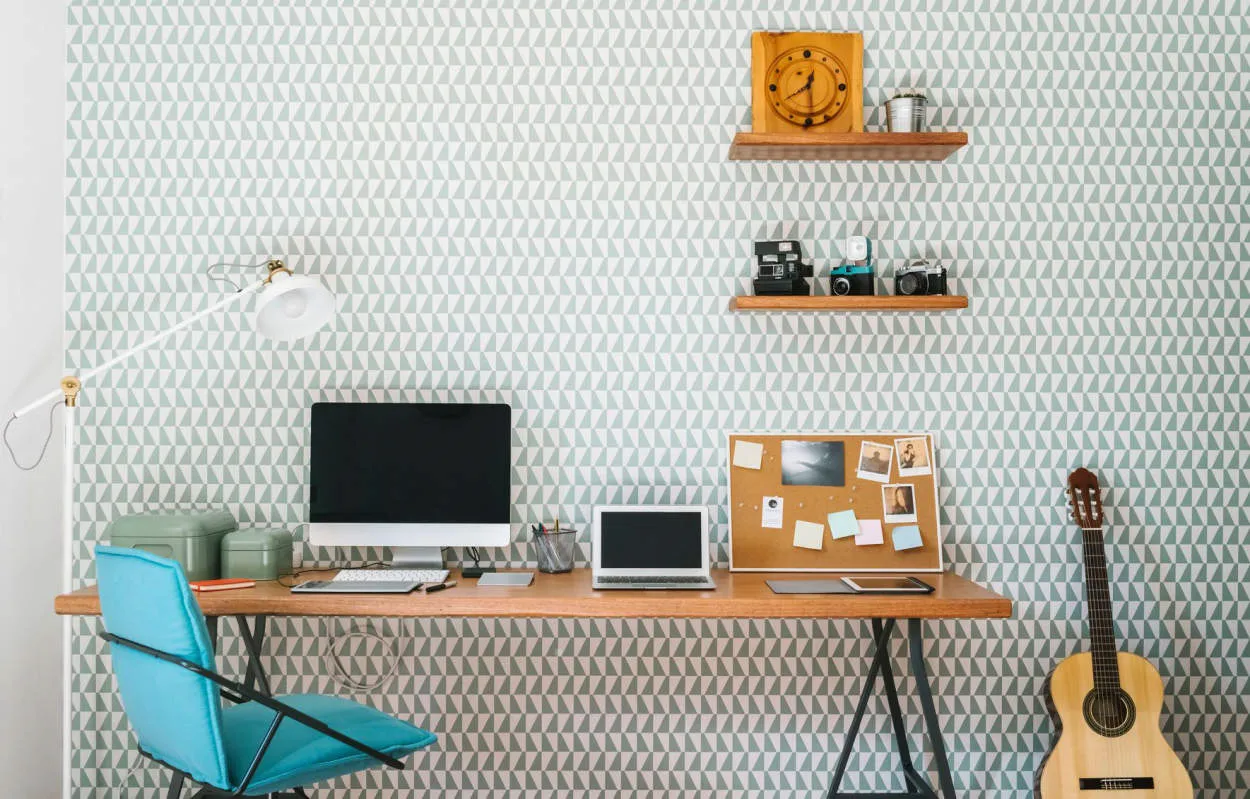When it comes to transforming a space, choosing the right wallpaper can make all the difference. In our article “Wallpaper Wonders: Selecting Designs That Make a Statement,” we delve into the world of wallpaper design, exploring how to find patterns and motifs that truly express your personal style and create an impactful statement in any room.
Bold vs. Subtle Patterns

When it comes to selecting wallpaper designs that make a statement, one of the key decisions to make is whether to opt for bold or subtle patterns. Both types of patterns have their own unique advantages and can add personality to any space. Here we explore the characteristics and considerations of each.
Bold Patterns
Bold patterns are eye-catching and instantly draw attention. They are characterized by strong colors, large-scale designs, and high contrasts. These patterns make a strong statement and can create a sense of drama and excitement in a room. However, it is important to use them strategically and in moderation to avoid overwhelming the space. Bold patterns are best suited for accent walls or areas where you want to create a focal point.
Subtle Patterns
On the other hand, subtle patterns offer a more understated and sophisticated look. They often feature softer colors, smaller-scale designs, and lower contrasts. Subtle patterns can add texture and depth to a space without overpowering it. They are versatile and work well in both small and large rooms, providing a serene and elegant ambiance. Subtle patterns can be used on all walls or as a backdrop for other elements in the room.
Considerations
When choosing between bold and subtle patterns, several factors come into play. The size of the room, the amount of natural light, and the existing decor should all be considered. In smaller spaces or rooms with limited natural light, opting for subtle patterns can help create an illusion of space and brightness. On the other hand, large rooms with abundant natural light can handle bold patterns without feeling cramped.
Additionally, the style and theme of the room should also be taken into account. Bold patterns may be more suitable for contemporary or eclectic spaces, while subtle patterns lend themselves well to traditional or minimalist designs.
Ultimately, the choice between bold and subtle patterns in wallpaper designs is a matter of personal preference and the desired ambience for each specific space. By understanding the characteristics and considerations of both options, you can confidently select a design that will enhance the overall aesthetic and make a statement in your home.
Choosing Colors that Complement
When it comes to selecting wallpaper designs that make a statement in your home, one of the most important aspects to consider is the color palette. The right combination of colors can transform a space and create a harmonious and visually appealing environment. Here are some tips for choosing colors that complement each other:
1. Stick to a color scheme:
Start by deciding on a color scheme that aligns with the mood and atmosphere you want to create. Consider the overall style of your home and the purpose of the room you are decorating. Whether you prefer warm, cool, neutral, or vibrant tones, keeping a cohesive color palette will ensure a unified look.
2. Use color theory:
Understanding color theory can be helpful when choosing complementary colors. The color wheel is divided into various categories, such as complementary, analogous, and triadic colors. Complementary colors are located opposite each other on the wheel and provide a high contrast and vibrant effect when combined.
3. Consider the room’s natural light:
The amount of natural light in a room can significantly influence how colors appear. Rooms with ample sunlight tend to make colors look brighter and more intense, while those with limited light may make colors appear darker and less saturated. Take this into account when selecting wallpaper colors to ensure they complement the room’s lighting conditions.
4. Balance warm and cool tones:
Incorporating both warm and cool tones can create a visually balanced and inviting space. For example, if you have a predominantly cool-toned wallpaper, introduce warm accents through furniture, artwork, or accessories to add depth and warmth to the room.
5. Test samples before committing:
Before making a final decision, it’s essential to test wallpaper samples in the actual space. Lighting, furniture, and existing decor can influence how colors interact with each other. By testing samples, you can assess how the colors complement the surrounding elements and make a more informed choice.
Remember, choosing colors that complement each other is key to creating an aesthetically pleasing and visually cohesive space. By following these tips, you can confidently select wallpaper designs that make a statement in your home.
Wallpaper for Different Room Types
When it comes to interior design, wallpaper can be a game-changer. It has the power to transform a space and create a unique atmosphere. To ensure you select the perfect wallpaper for your room, it’s important to consider the specific characteristics of each space. Here are some tips for choosing wallpaper designs that complement different room types:
Living Room
The living room is often the centerpiece of a home, so it’s essential to choose a wallpaper that reflects your personal style. Opt for bold patterns or vibrant colors to make a statement. If you prefer a more subdued look, consider textured wallpaper or a neutral-toned design that adds depth without overwhelming the space.
Bedroom
In the bedroom, creating a serene environment is key. Soft, calming colors like pastels or neutrals can help to promote relaxation and restful sleep. Floral or nature-inspired designs can also create a soothing atmosphere. Alternatively, choose a statement wallpaper for a focal point behind the bed to add some personality to the room.
Kitchen
The kitchen is a space where functionality is essential, but that doesn’t mean you have to compromise on style. Opt for washable and durable wallpaper that can withstand humidity and occasional splatters. Geometric patterns or simple designs with a splash of color can add a touch of personality without overwhelming the space.
Bathroom
In the bathroom, moisture resistance is vital when selecting wallpaper. Look for vinyl or waterproof options that can withstand the humidity. For a spa-like ambiance, consider textured designs or subtle patterns. Light colors can also help to create a clean and airy feel.
Home Office
When it comes to the home office, selecting a wallpaper that promotes focus and productivity is crucial. Opt for calm, neutral tones or subtle patterns that won’t distract you while working. If you want to add character, choose a wallpaper with a simple design or a small-scale repeating pattern.
Remember, the key to successful wallpaper selection is to choose designs that complement the room’s function and overall aesthetic. Whether you’re going for a bold statement or a subtle backdrop, there’s a wallpaper design out there to suit every room type.
The Role of Lighting in Wallpaper Selection
When it comes to selecting wallpaper designs that make a statement, lighting plays a crucial role in enhancing the overall aesthetic and ambiance of any room. The way lighting interacts with wallpaper can completely transform its appearance, creating different effects and highlighting unique features.
Proper lighting can bring out the true colors and texture of the wallpaper, making it more vibrant and visually appealing. On the other hand, poor lighting can overshadow the design and make the wallpaper look dull and unimpressive. Therefore, it is essential to consider the lighting conditions in a room before finalizing a wallpaper choice.
One important factor to consider is the natural lighting available in the room. Rooms with abundant natural light allow for a wider range of wallpaper options. The changing intensity and direction of sunlight throughout the day can create beautiful effects on the wallpaper, bringing it to life. It is important to take into account how the wallpaper will look under different lighting conditions throughout the day.
In spaces with limited natural light, artificial lighting becomes even more crucial. Choosing the right type of artificial lighting can greatly impact the overall effect of the wallpaper. Different light fixtures, such as chandeliers, sconces, or recessed lighting, can create various atmospheres and highlight different aspects of the wallpaper design.
Additionally, considering the color temperature of the lighting is important for achieving the desired atmosphere. Warm lighting, with a yellowish hue, can create a cozy and inviting ambiance, while cool lighting, with a bluish hue, can add a sense of freshness and modernity. The color temperature should be chosen according to the mood and style intended for the room.
Furthermore, the direction and placement of lighting fixtures should be carefully considered. Wallpapers with intricate patterns or textures can be accentuated by placing light fixtures strategically to create interesting shadows and depth. Highlighting specific areas of the wallpaper can draw attention to its unique features and create a focal point in the room.
In conclusion, when selecting wallpaper designs that make a statement, the role of lighting should not be overlooked. Proper lighting enhances the visual impact of the wallpaper, highlighting its colors, texture, and design features. Whether it is natural or artificial lighting, the right choices can transform the overall ambiance of a room and make the wallpaper truly shine.
Textured Wallpaper Options
When it comes to selecting wallpaper designs that make a statement, textured options are a great choice. They add depth and visual interest to any room, creating a unique and sophisticated look. Here are a few textured wallpaper options to consider:
1. Embossed Wallpaper
Embossed wallpaper features raised patterns that give a three-dimensional effect. This type of textured wallpaper is perfect for adding elegance and charm to a room. Choose from a variety of embossed designs like floral, geometric, or damask.
2. Grasscloth Wallpaper
Grasscloth wallpaper is made from natural materials like jute, sisal, or bamboo, giving it a rustic and organic texture. It adds warmth and a touch of nature to any space. Keep in mind that grasscloth wallpaper requires delicate care and is best suited for low-traffic areas.
3. Flocked Wallpaper
Flocked wallpaper features a velvety texture created by applying fibers or small particles to the surface. It adds a luxurious and glamorous touch to a room. Opt for flocked wallpaper with bold patterns or choose a more subtle design for a sophisticated look.
4. Cork Wallpaper
Cork wallpaper is a unique option that provides both texture and natural insulation. It is environmentally friendly and often used to create a cozy and inviting atmosphere. Cork wallpaper is also great for reducing noise in a room.
These are just a few examples of textured wallpaper options available in the market. Consider your overall design theme and personal style when selecting the right textured wallpaper for your space. Remember to always sample the wallpaper before making a final decision to ensure it complements your interior perfectly.
DIY Wallpaper Installation Tips
Installing wallpaper can be a fun and creative way to transform the look and feel of a room. Whether you’re a beginner or have some experience, these DIY wallpaper installation tips will help you achieve a professional-looking result:
Selecting the Right Wallpaper
Before you start the installation process, consider the type of wallpaper that suits your needs. Vinyl wallpapers are generally more durable and easy to clean, making them suitable for high-traffic areas such as kitchens and bathrooms. On the other hand, fabric or textured wallpapers can add an elegant touch to living rooms or bedrooms.
Preparing the Wall Surface
Proper preparation is key to a successful wallpaper installation. Make sure the wall surface is clean, smooth, and free from any dirt or imperfections. Fill any holes or cracks with spackling compound and sand the surface to create a smooth canvas for the wallpaper.
Measuring and Cutting
Measure the height and width of your walls accurately before cutting the wallpaper. Add a few inches of extra length at the top and bottom to account for any variations in ceiling and floor levels. Use a sharp utility knife or wallpaper cutter to make precise cuts.
Applying the Wallpaper
Start by applying wallpaper paste or adhesive to the back of the wallpaper according to the manufacturer’s instructions. Then, carefully position the first strip of wallpaper on the wall, ensuring it is level and aligned with the reference points. Smooth out any air bubbles or wrinkles using a wallpaper brush or sponge.
Matching Patterns
If your wallpaper has a pattern, take extra care to align the patterns correctly between strips. This will create a seamless look and avoid any visual inconsistencies. Match the patterns by overlapping the edges slightly and using a sharp blade to trim the excess.
Finishing Touches
After applying all the wallpaper strips, gently wipe away any excess glue with a damp sponge or cloth. Use a wallpaper seam roller to ensure the edges are securely sealed. Allow the wallpaper to dry completely before moving or arranging furniture in the room.
Remember, practice makes perfect. Don’t be discouraged if you encounter challenges during your first wallpaper installation. With time and experience, you’ll master this DIY skill and be able to create stunning statement walls in your home.
Conclusion
When it comes to selecting wallpaper designs that make a statement, it’s important to consider the overall aesthetic, mood, and theme of the space. The right wallpaper can transform a room and add personality and style. Whether you prefer bold and vibrant patterns or subtle and understated designs, choose wallpapers that reflect your unique taste and create a cohesive look throughout your home.



